Table of contents
Getting Started with Maintenance
Thursday December 7, 2023-11 min readIntroduction
The Maintenance app is designed to help organizations manage essential work tasks. It’s important to complete maintenance tasks at an efficient pace to stay on track and ensure business assets are functioning optimally. This guide will show you how to view and complete important work tasks, created from Maintenance Director.
Let’s get started
To access the Maintenance app, navigate to the Operations section of the main navigation bar and select Maintenance.
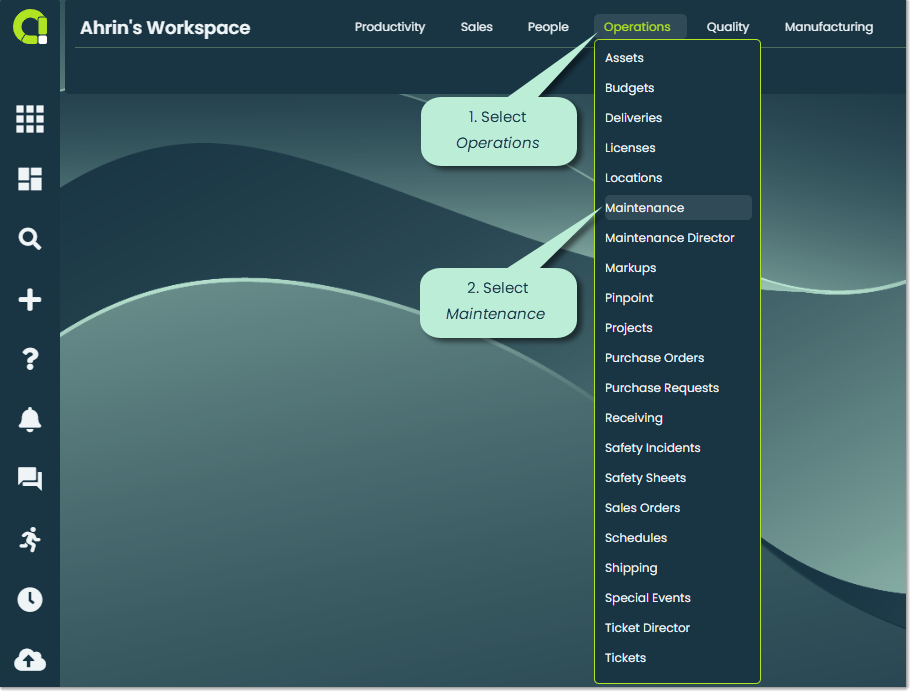
When the app first opens, you’ll be greeted by the main app screen. Let’s go over the features of each tab.
Note: This screen will be empty if this is your organization’s first time using Maintenance or Maintenance Director.
Work Tasks – This will be the default tab when you first open the app. Work Tasks gives you a full list of tasks within your organization and consolidates the important information in an easy to use view. You have the option of sorting the list by the inner tabs All tasks or Scheduled today.
All tasks: Displays every work task within your organization.
Scheduled today: This inner tab highlights the tasks scheduled for the current day.
People – This tab shows a list of contacts within your organization who are currently or were previously assigned a work task. It’s a convenient way to promptly identify the tasks assigned to a specific individual.
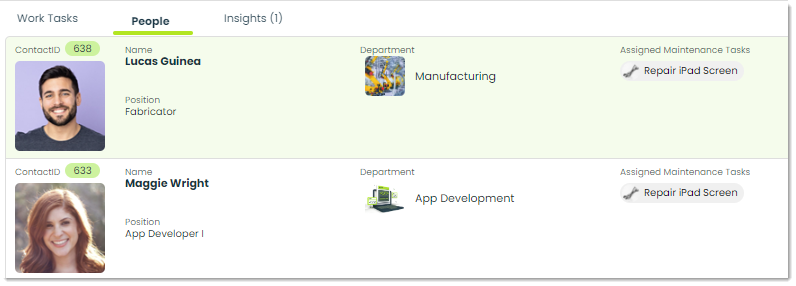
Insights – This tab is designed for analyzing data from your organization’s maintenance tasks. With Insights, you can uncover and make use of valuable information related to task types, status, and labor allocations. To learn more about Insights, please refer to our guide Getting Started with Insights.
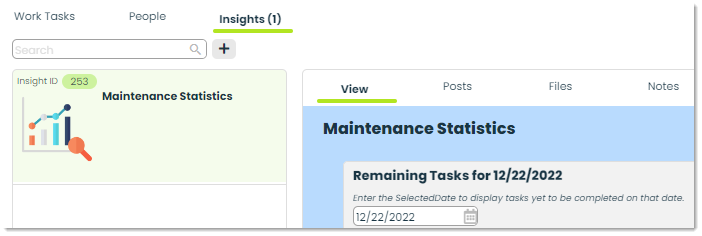
How to view work tasks
To view existing work tasks, navigate to the Work Tasks tab at the top of the app screen. This tab will display a list of work tasks within your organization, and sort them according to your preferences.

You can view the details of a work task by clicking on it in the Work Tasks tab. Let’s go over the fields

You’ll then be shown a details flyout, showing you the specifics of the work task. Let’s go over what each of the fields represents.
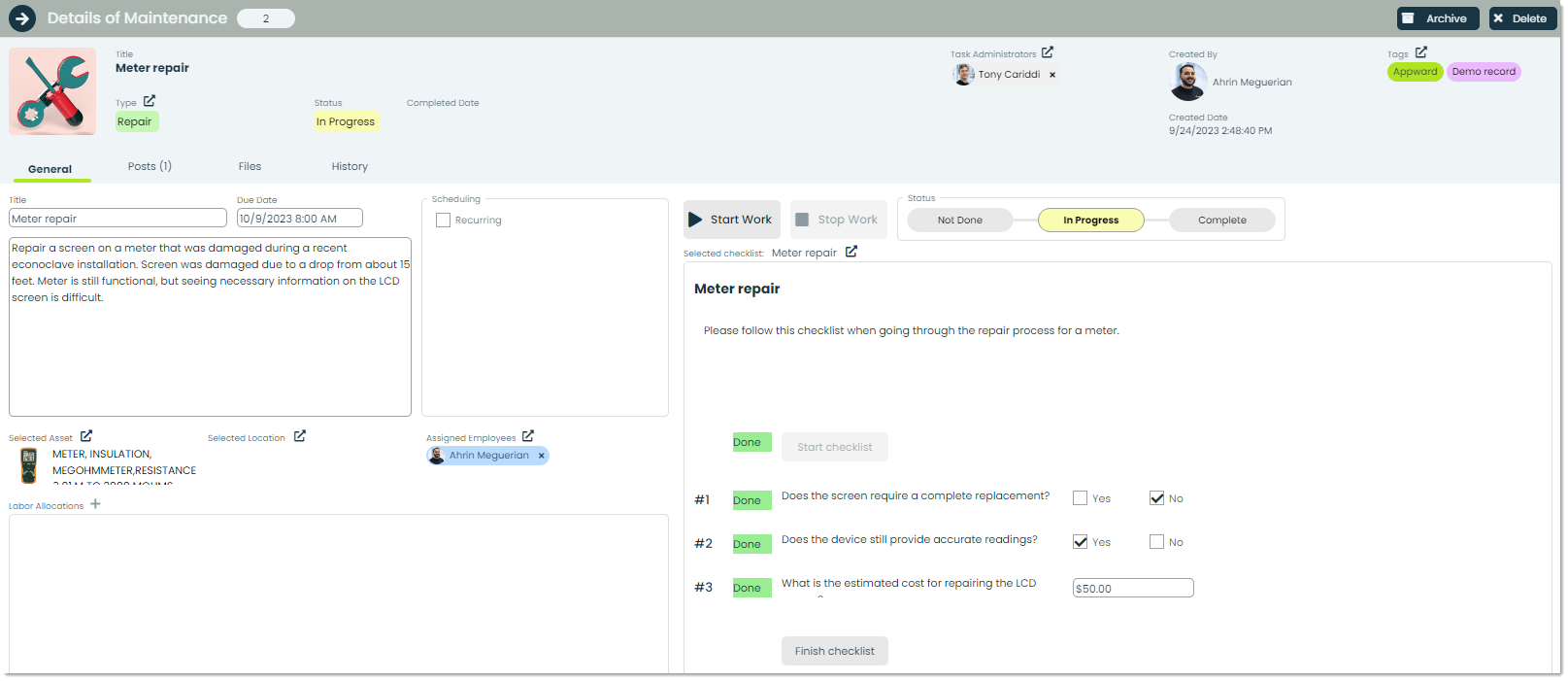
Title – A brief and descriptive name or label for the work task.

Due Date – The deadline or scheduled date by which the maintenance task is expected to be completed.

Description – A detailed explanation about the work tasks, providing context and guidance for the contacts who will be responsible for carrying out the task.

Type – When it comes to work tasks, you can classify them based on the specific type you choose. These types, visually represented as labels with custom names, colors, and images, can be applied to maintenance records within Appward. Types offer a highly adaptable and personalized approach to organizing your maintenance data according to your business needs. For example, if you’re completing a task on an Econoclave, you can assign the task type “Econoclave” to it. To learn more about how to use types, please refer to our article Using Types.

Scheduling – This is where you can schedule the day and time the task is expected to be completed. You can make the maintenance task a recurring task, which is especially helpful for tasks that need to be completed on a week-to-week basis. To do so, you can select the Recurring checkbox and define the day and start date for the upcoming scheduled tasks.
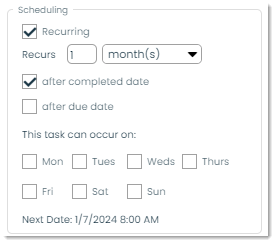
Selected Asset – In Selected Asset, you can view and select the specific organization asset the maintenance work task is associated with or intended for. To edit this field, simply click on the external link icon

Selected Location – The Selected Location is defined as the designated place within your organization where the maintenance work task is going to be carried out. It’s important to note that work tasks can occur on locations themselves, without any specific asset associated.

Assigned Employees – In Assigned Employees, you can view or select the employees who are responsible for carrying out the maintenance task. If you want to pick or modify individuals in this category, simply click on the external link icon and make your selection from a list of employees within your organization.

Labor Allocations – Labor Allocations refers to the distribution of your organization’s labor for this specific work task. This field details the quantity of labor needed for each person involved in the task.

Start/Stop work – Ensuring that employees can effortless monitor their work on maintenance tasks is essential. The Start Work and Stop Work buttons enables assigned employees to indicate when they start or stop working on a maintenance task. This functionality not only tracks the time spent by the employee, but also helps in calculating the cost of labor required from start to finish.

Status – Within the Status field, you can monitor the real-time progress of the work task. This status is updated with the Start Work and Stop Work buttons. Upon an employee’s initial selection of starting the work, the status will change to In Progress. If you are a task administrator, you can modify the status by clicking on the option that aligns best with the current state of the task.
Not Done: Indicates that the work task has not been completed yet. This can also mean that it has not been started.
In Progress: The task is actively being worked on.
Complete: Indicates the task has been finished successfully.

Selected checklist – You have the option to link a checklist with a work task. These checklists are initially generated using the Checklist Creator app and can be utilized across various apps within Appward. To choose a checklist, simply click on the external link icon and make your selection from the list of available checklists within your organization.
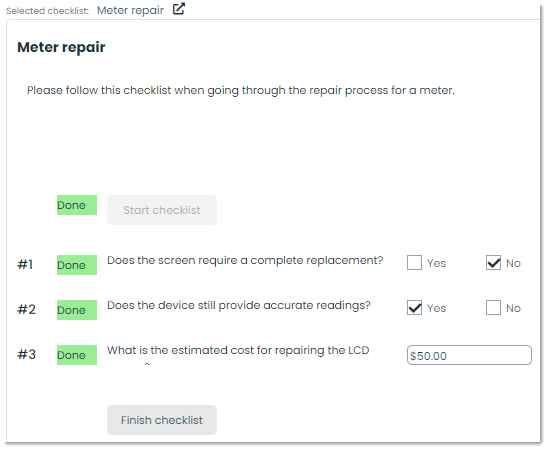
Viewing work tasks by contact
To access a list of contacts from your organization who have been assigned work tasks, navigate to the People tab. At first glance, you can see the employee’s name, position, department and their assigned maintenance tasks.

To view more details about the employee, click on their record. A details flyout will appear, showing you more details about their assigned maintenance tasks. In this flyout, you’ll find identical details as presented in the Work Tasks tab. Examining the details within the context of viewing an employee’s record enables you to navigate through your organization’s complete list of work tasks and concentrate on those associated with a specific employee.

Frontline features of Maintenance
Posts – A post is a comment which can be replied and reacted to by other users in your organization. For instance, you can use a post to have a discussion about the ongoing status of a work task or to quickly communicate a comment about a task to a team member.

Files – Through the Files tab, you can attach essential documents to a maintenance record. You can add files directly from your computer or from the Appward cloud. After adding a file, you can view it through an integrated document preview on the right side of the Files section. Individuals within your organization with access to the record can view and download the file to their personal computers.

History – In History, you can view an activity log related to the Maintenance record you are viewing. You will see a list displaying the change date, activity description, change author, and the application in which it was made.

Additional features of Maintenance
Archive – Archiving is a commonly featured function in many applications within Appward. It serves as a valuable tool for temporarily concealing a record without permanently removing it. Archived records are essentially hidden from the primary screen but remain accessible through specific search filters.

Delete – To permanently remove a maintenance record, simply click the Delete button. An additional confirmation popup will appear to verify your choice, but please be certain, as this action is irreversible.

